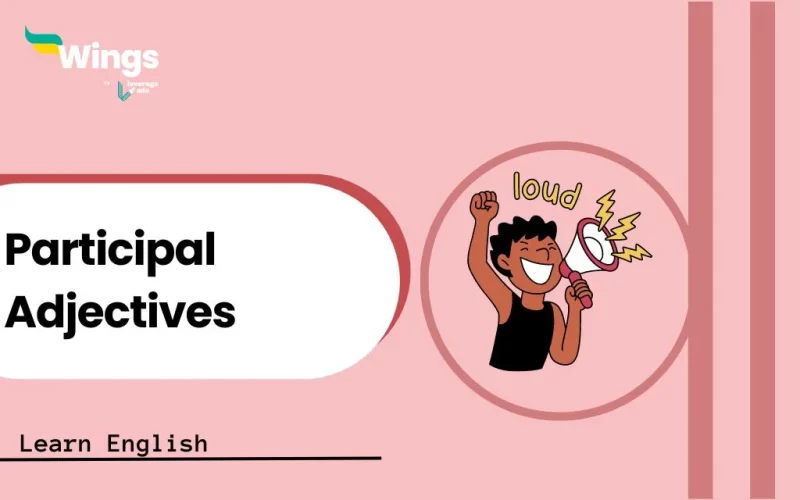Whenever there is a hint of specification or demonstration towards a noun or pronoun in English, you would find a flavour of adjectives preceding that description. But, it becomes even more mesmerising that a few additions of suffixes like ‘-ed’ and ‘-ing’ within those same adjectives can make a greater difference. That is what Participial Adjectives are for, a participle in form and origin, and a specialist of verbal and deverbal adjectives.
However, there is more to them than meets the eye. Therefore, let’s dive into this blog article together and learn more about what are participial adjectives and how to use them like a grammar nazi.
This Blog Includes:
Learn More About Adjective: Definition, Usage, Example, Forms, and Types here!
What are Participial Adjectives?
If you go by the books, you will find a great deal of similarity in form between participial adjectives and participles. Therefore, you are bound to learn more about Present and Past participles alongside this adjective. But, for now, you should note that the formation of Participial Adjectives stems from the roots of verbs. As a result, it becomes synonymous with verbal and deverbal adjectives.
You would mainly notice suffixes “-ed” and “-ing” in participial adjectives, except for irregular participles like hidden, grown, and broken, a few to mention. Let’s take a look at the following examples for reference:
| Participial Adjective | Examples |
| Running | The running child was out of breath. |
| Broken | The broken window was repaired. |
| Excited | The excited crowd cheered wildly. |
| Confused | The confused student asked for help. |
| Interested | The interested shopper asked many questions. |
Quick Read: What are Comparative and Superlative Adjectives? Everything You Need to Know
Types of Participial Adjectives
There are mainly two types of participles you should focus on to master the usage of participial adjectives. Both of these participles are worthy of acting as adjectives, which we will unravel through the description below.
Present Participle as Participial Adjectives
If a verb is ending with (-ing), it comes under the category of the present participle. Furthermore, its definition suggests that these adjectives are representatives of ongoing actions or the happenings of the present.
For Example: Running, Walking, Talking, Singing, Dancing, etc.
Learn About Present Tense Here!
Past Participle as Participial Adjectives
On the other hand, if you find a verb ending in (-ed), you can consider it a past participle. Because this participle describes the happenings of the past. In short, the action must have already taken place before the discussion.
For Example: Broken, Finished, Eaten, Read, Written, etc.
Learn About Past Tense Here!
How to Use Participial Adjectives in a Sentence?
You do not need to burn the midnight oil To use Participials in your writing and speeches. All that is required is the implementation of these simple rules and half of the battle is won.
Rule 1: Place the adjective next to the nouns.
Example
- The running child was out of breath.
- The broken window was repaired.
Rule 2: Use participial adjectives to create prepositional phrases.
Example
- The book is lying on the table.
- The car is parked in the garage.
Rule 3: Avoid the usage of numerous participial adjectives in one sentence/row.
Example
- The running child, laughing and shouting, ran down the street. [Incorrect❎]
- The child ran down the street, laughing and shouting. [Correct✅]
Do Check Out: Leverage Edu Learn English Youtube Channel
Participial Adjectives Examples
Now that we have come this far, let’s check the following examples of participial adjectives and wrap up our learnings on a complete note:
- The thundering clouds brought heavy rain.
- The blooming flowers filled the garden with colour.
- The rising sun casts a golden light over the landscape.
- The falling leaves danced in the autumn breeze.
- The laughing children played happily in the park.
- The painted wall looked beautiful.
- The carved wooden statue was a masterpiece.
- The sewn dress fit perfectly.
- The cooked chicken was juicy and tender.
- The baked cake was sweet and delicious.
Explore more Exciting Reads on Adjectives Here!
Explore more exciting reads below:
This was all about the Participial Adjectives and how to use them. Hope you understand the concept and where it’s used. You can also follow Leverage Edu for more exciting and informative blogs.
 One app for all your study abroad needs
One app for all your study abroad needs














 45,000+ students realised their study abroad dream with us. Take the first step today.
45,000+ students realised their study abroad dream with us. Take the first step today.

